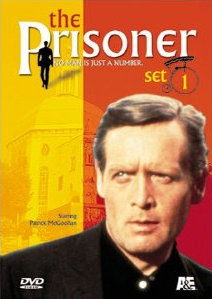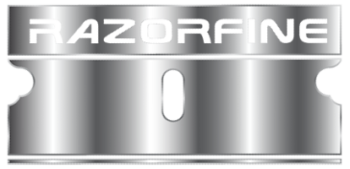- Title: The Prisoner
- tv.com: link
 The most original show ever made, and perhaps the best art form ever shown on television, The Prisoner is simply a masterpiece. Hailed as the first television classic, Patrick McGoohan’s allegory of an individual being trapped in a modern society that wants nothing more or less than to break him down into meaningless number is gripping television. More art than television, the show has been compared to Franz Kafka, George Orwell, Lewis Carroll, Aldous Huxley, G.K. Chesterton, Jonathan Swift, Gustav Meyrink, Alfred Kubin and the surrealist painters such as Rene Magritte. The show created awe, hysteria, and finally a profound appreciation for McGoohan’s masterpiece that stands alone as a shining example of what television can, and for at least one year strove, to be. It raises as many questions as answers, but does both with style. The show certainly wasn’t made for the casual viewer, or in an attempt to create a huge hit for the BBC. In McGoohan’s own words, It’s “not to everyone’s taste. It was never intended to be. I wasn’t making Coca-Cola.” No, it was in fact something much, much sweeter.
The most original show ever made, and perhaps the best art form ever shown on television, The Prisoner is simply a masterpiece. Hailed as the first television classic, Patrick McGoohan’s allegory of an individual being trapped in a modern society that wants nothing more or less than to break him down into meaningless number is gripping television. More art than television, the show has been compared to Franz Kafka, George Orwell, Lewis Carroll, Aldous Huxley, G.K. Chesterton, Jonathan Swift, Gustav Meyrink, Alfred Kubin and the surrealist painters such as Rene Magritte. The show created awe, hysteria, and finally a profound appreciation for McGoohan’s masterpiece that stands alone as a shining example of what television can, and for at least one year strove, to be. It raises as many questions as answers, but does both with style. The show certainly wasn’t made for the casual viewer, or in an attempt to create a huge hit for the BBC. In McGoohan’s own words, It’s “not to everyone’s taste. It was never intended to be. I wasn’t making Coca-Cola.” No, it was in fact something much, much sweeter.
In 1966 Patrick McGoohan had a successful television show (Danger Man), celebrity, money and fame, and decided to step away from it all to work on a new project. The story goes that at a cocktail party one night someone asked McGoohan what a spy does after he retires. The innocuous comment was a jest about what he’d do once he stepped away from the part of John Drake on Danger Man (also known as Secret Agent). McGoohan took the question literally however and abandoned the first colorized season of Danger Man only two episodes into the shoot. McGoohan sat down and began writing what would become one of the most famous, and infamous, shows ever to air, The Prisoner. The fact that McGoohan got out of his contract so easily and was given the largest budget of any British television show (by more than 40%), a contract for seventeen episodes, and had not yet turned in one completed script before the pilot was finished, can tell you how big of a star he had become (he actually turned down the role of 007 before it was offered to Sean Connery).
What McGoohan set out to create was not an average spy story, but something that would transform television and take it to a new level. In his own words he set out to create “an allegorical conundrum for people to interpret for themselves.” The show became an instant success in Britain, and in the U.S. where it appeared the following year. The last episode though left some fans so angry that McGoohan had to flee the country until the heat died down. True to his word he had not spilled all the secrets, he had kept many to himself and left an open end to the series that allowed individuals to decide the meaning of the show for themselves. McGoohan wanted the issues he raised to be debated and was surprised at the level of hostility, but acknowledged that the series had met his every objective. McGoohan is constantly putting the freedom of the individual (No. 6) against the well being of society (the village). The show also plays on McGoohan’s deep distrust of burgeoning technology that mankind is not yet prepared and may never be ready for. One of the symbols that appears in the series is the pennyfarthing bicycle which symbolizes a need to slow the rapid advancement of technology until mankind has matured enough for its use. It is no coincidence that most of the technology is used to try and destroy and break down No. 6 in rather despecable means.
In the opening montage we watch a man (Patrick McGoohan) drive to a government building, burst into his boss’ office and throw down his resignation. We can not hear his words due to the musical score, but we watch as he makes his way home followed by a mysterious man driving a hearse. As our protagonist begins to pack, the strange man pumps gas into the apartment. He awakes to find himself in what appears to be his apartment, but when he looks out the window he finds himself to have been transported to a very strange sea resort village. He attempts to use the phone and then the taxi service only to be told they use only local service. The only maps provided sold are maps of the village which describe the surrounding areas only as mountains or sea. Finally he makes his way to the green dome to meet number 2, who explains that the village is a home for those like himself who have useful and even dangerous, knowledge. Every member of the village has a number; our protagonist is assigned the number 6 for identification. Despite his refusal to take on the mantle of No. 6 he is never referred to by any other name throughout the length of the series. No. 6’s attempt to escape the village is stopped by a monstrous white sphere that envelopes him and returns him to No. 2. Throughout the rest of the series No. 6 will continue to try and escape the village while whoever is in charge of the village sends new No. 2’s to match wits with our protagonist and break him to make him give up his important knowledge.
Although each episode has a specific plot, there are two main themes that run through the show. The first is No. 6’s repeated attempts to escape the village. The other is the various No. 2’s trying to pry the truth from the prisoner about the reasons behind his resignation. The methods for prying this information out of No. 6 include drugs, torture, untested medical procedures, hallucinated reality, blackmail, threats, and isolation, among others. The show is not for younger viewers, but at the same time such actions that are taken are always as much suggested as shown and the show never cheapens itself by relying on unnecessary violence. Although the show is an action drama, the main goal is always to promote the discussion of the issues McGoohan tries to raise in an entertaining way.
The entire series is exceptionally well done, but I’ll spend a few lines on some of my favorite episodes. Living in Harmony blends the series with that of a classic western as our prisoner finds himself a former sheriff who has turned in his gun and badge and is stuck in the town of Harmony. It’s the only episode of the show that wasn’t originally shown in the United States because of the prisoner’s unwillingness to fight was seen as subversive during the US involvement in Vietnam. The Chimes of Big Ben, Checkmate, and Many Happy Returns focus on the prisoner’s attempts to escape, and give us a few crumbs about his past. Free For All is a biting satire of the democratic process where No. 6 runs for the post of No. 2, and in much the same way The General subtly attacks the educational system of the time period. In A., B., & C. and Schizoid Man the village tries through various means of drugs and technology to break down our protaganist and force him to give up his precious information. The final episode of the series Fall Out is by far the most controversial. The episode reflects the surreal style of the series and the answers it does provide lead only to other questions. McGoohan purposefully left the ending ambiguous to allow the audience to decide for themselves, as individuals, the meaning of what has been revealed. Although many were angered at the obscure ending, it has been analyzed and debated for years, just as McGoohan wanted.
The Prisoner can be bought in small two disc volumes ($39.95) or The Complete Prisoner with all ten discs ($150). It’s a steep price-tag for the number of hours you get per disc (you are paying about ($10 per hour for the complete package). Just like the show, this collection is not for everyone, but then again this is really a one-of-a-kind collection. Each disc gets its own case, and all the cases fit into a protective sleeve making it a rather nice set piece. As for the extras, there are tons of still shots in the photo galleries on each disc, some rather amusing trivia challenges, original trailers, and two documentaries, but sadly no commentary tracks or interviews with McGoohan himself. The first documentary is an interview with Bernie Williams, the production manager for the show. The second documentary is more of a retrospective examining the show after all these years. Both are interesting and add some insight, though do not try to answer the questions McGoohan left unanswered at the end of the series. The other extra is the “alternative” version of The Chimes of Big Ben. Other than differences in the credit sequences and the absence of the show’s normal musical score there really is not too much of interest here except for the more rabid Prisoner fan base. All together, it’s quite a nice collection, though pretty pricey for all but diehard fans of the show. I would have loved some commentary tracks or an interview with McGoohan himself, but I understand his reasoning for wanting to leave the show in the past and not try to answer questions that he never intended to answer in the first place.
This is truly one of the rare finds in television. Although quite expensive, you are paying about $15 per disc here, it remains one of the most original shows ever produced for television. The show is priced a little high for the casual observer, but then you have to remember McGoohan was never interested in them anyway. The extras contained in the box, especially the two documentaries are very informative in discussing the making of the series and the ideas behind them as well. As a whole the 17 episodes stand up well today, with one or two dated technology moments mostly in The General. The show tried to do something no television show had done before, and we had to wait almost thirty years before another would pick up the reigns and examine these issues again (UPN’s one season run of Nowhere Man read that review here). It’s a must have in the collection of a true TV connoisseur, and the most thought provoking, artistic shows that has ever or will ever air on television. Be seeing you!
